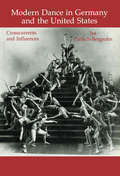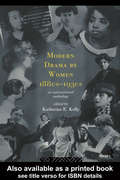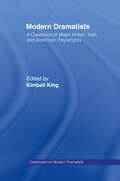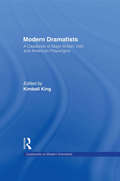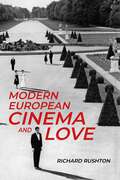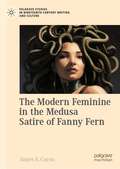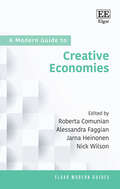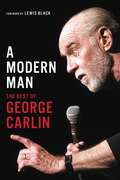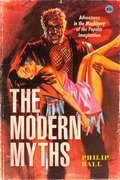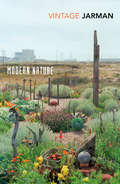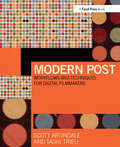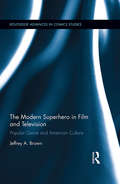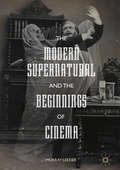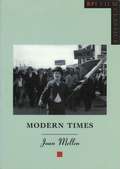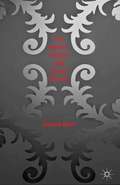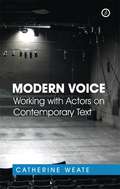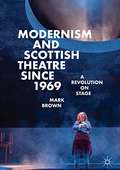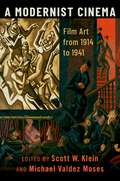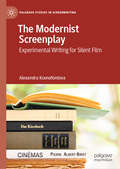- Table View
- List View
Modern Dance in Germany and the United States: Crosscurrents and Influences (Choreography and Dance Studies Series)
by Isa Partsch-BergsohnFirst Published in 1995. Routledge is an imprint of Taylor & Francis, an informa company.
Modern Drama by Women 1880s-1930s: An International Anthology
by Katherine E. KellyModern Drama by Women 1880s-1930s offers the first direct evidence that women playwrights helped create the movement known as Modern Drama. It contains twelve plays by women from the Americas, Europe and Asia, spanning a national and stylistic range from Swedish realism to Russian symbolism. Six of these plays are appearing in their first English-language translation. Playwrights include: * Anne-Charlotte Leffler Edgren (Sweden) * Amelai Pincherle Rosselli (Italy) * Elsa Berstein (Germany) * Elizabeth Robins (Britain) * Marie Leneru (France) * Alfonsina Storni (Argentina) * Hella Wuolijoki (Finland) * Hasegawa Shigure (Japan) * Rachilde (France) * Zinaida Gippius (Russia) * Djuna Barnes (USA) * Marita Bonner (USA) This groundbreaking anthology explodes the traditional canon. In these plays, the New Woman represents herself and her crises in all of the styles and genres available to the modern dramatist. Unprecedented in diversity and scope, it is a collection which no scholar, student or lover of modern drama can afford to miss.
Modern Drama by Women 1880s-1930s
by Katherine E. KellyModern Drama by Women 1880s-1930s offers the first direct evidence that women playwrights helped create the movement known as Modern Drama. It contains twelve plays by women from the Americas, Europe and Asia, spanning a national and stylistic range from Swedish realism to Russian symbolism. Six of these plays are appearing in their first English-language translation. Playwrights include: * Anne-Charlotte Leffler Edgren (Sweden) * Amelai Pincherle Rosselli (Italy) * Elsa Berstein (Germany) * Elizabeth Robins (Britain) * Marie Leneru (France) * Alfonsina Storni (Argentina) * Hella Wuolijoki (Finland) * Hasegawa Shigure (Japan) * Rachilde (France) * Zinaida Gippius (Russia) * Djuna Barnes (USA) * Marita Bonner (USA) This groundbreaking anthology explodes the traditional canon. In these plays, the New Woman represents herself and her crises in all of the styles and genres available to the modern dramatist. Unprecedented in diversity and scope, it is a collection which no scholar, student or lover of modern drama can afford to miss.
Modern Dramatists: A Casebook of Major British, Irish, and American Playwrights (Studies in Modern Drama #Vol. 14)
by Kimball KingThis comprehensive collection gathers critical essays on the major works of the foremost American and British playwrights of the 20th century, written by leading figures in drama/performance studies.
Modern Dramatists: A Casebook of Major British, Irish, and American Playwrights (Studies in Modern Drama)
by Kimball KingThis comprehensive collection gathers critical essays on the major works of the foremost American and British playwrights of the 20th century, written by leading figures in drama/performance studies.
Modern European cinema and love
by Richard RushtonModern European cinema and love examines nine European directors whose films contain stories about romantic love and marriage. The directors are Jean Renoir, Ingmar Bergman, Alain Resnais, Michelangelo Antonioni, Agnès Varda, François Truffaut, Federico Fellini, Jean-Luc Godard and Éric Rohmer. The book approaches questions of love and marriage from a philosophical perspective, applying the ideas of authors such as Stanley Cavell, Leo Bersani, Luce Irigaray and Alain Badiou, while also tracing key concepts from Freudian psychoanalysis. Each of the filmmakers engages deeply with notions of modern love and marriage, often in positive ways, but also in ways that question the institutions of love, marriage and the ‘couple’.
Modern European cinema and love
by Richard RushtonModern European cinema and love examines nine European directors whose films contain stories about romantic love and marriage. The directors are Jean Renoir, Ingmar Bergman, Alain Resnais, Michelangelo Antonioni, Agnès Varda, François Truffaut, Federico Fellini, Jean-Luc Godard and Éric Rohmer. The book approaches questions of love and marriage from a philosophical perspective, applying the ideas of authors such as Stanley Cavell, Leo Bersani, Luce Irigaray and Alain Badiou, while also tracing key concepts from Freudian psychoanalysis. Each of the filmmakers engages deeply with notions of modern love and marriage, often in positive ways, but also in ways that question the institutions of love, marriage and the ‘couple’.
The Modern Feminine in the Medusa Satire of Fanny Fern (Palgrave Studies in Nineteenth-Century Writing and Culture)
by James E. CaronThe Modern Feminine in the Medusa Satire of Fanny Fern argues that Sara Parton and her literary alter ego, Fanny Fern, occupy a star-power position within the antebellum literary marketplace dominated by women authors of sentimental fiction, writers Nathaniel Hawthorne (in)famously called “the damn mob of scribbling women.” The Fanny Fern persona represents a nineteenth-century woman voicing the modern feminine within a laughter-provoking bourgeois carnival, a forerunner of Hélène Cixous’s laughing Medusa figure and her theory about écriture féminine. By advancing an innovative theory about an Anglo-American aesthetic, comic belles lettres, Caron explains the comic nuances of Parton’s persona, capable of both an amiable and a caustic satire. The book traces Parton’s burgeoning celebrity, analyzes her satires on cultural expectations of gendered behavior, and provides a close look at her variegated comic style. The book then makes two first-order conclusions: Parton not only offers a unique profile for antebellum women comic writers, but her Fanny Fern persona also anchors a potential genealogy of women comic writers and activists, down to the present day, who could fit Kate Clinton’s concept of fumerism, a feminist style of humor that fumes, that embraces the comic power of a Medusa satire.
A Modern Guide to Creative Economies (Elgar Modern Guides)
Bringing together a series of new perspectives and reflections on creative economies, this insightful Modern Guide expands and challenges current knowledge in the field. Interdisciplinary in scope, it features a broad range of contributions from both leading and emerging scholars, which provide innovative, critical research into a wide range of disciplines, including arts and cultural management, cultural policy, cultural sociology, economics, entrepreneurship, management and business studies, geography, humanities, and media studies.Designed to push the boundaries of understanding on the topic, this Modern Guide initially addresses definitional and methodological challenges, before offering new perspectives on the theory and practice of creative and cultural entrepreneurship, and exploring the role of networks and the importance of place and mobility. The book concludes by re-imagining creative economies, raising issues of inequality and justice, care and solidarity, and opportunities for value recognition, while providing new visions of inclusivity, cultural capability, and future development.A timely reflection on the importance of creative economies, this Modern Guide will be a critical read for students, scholars and policymakers working to support and develop future inclusive and sustainable creative economies.
A Modern Man: The Best of George Carlin
by George CarlinExperience George Carlin as you&’ve never seen him in this collection highlighting his greatest hits and achievements, including never-before-seen material. It is impossible to talk about 20th century comedy without discussing George Carlin. Named the 2nd greatest standup of the 20th century by both Comedy Central and Rolling Stone, Carlin garnered multiple gold records, 4 Grammys, 6 Emmy nominations, and the Mark Twain Prize for American Humor. He was the first host of SNL, appeared on the Tonight Show some 130 times, and acted in beloved films like Bill and Ted&’s Excellent Adventure and Dogma. Dubbed &“the dean of counterculture comedians,&” George Carlin was an American icon. A perfect introduction for new fans and a worthy addition to the collections of old fans, The Best of Carlin showcases the longevity, range, and—above all—hilarity of the master. Filled with thoughts, musings, questions, lists, beliefs, curiosities, monologues, assertions, assumptions, and other delicious verbal ordeals, it is drop-dead funny tour through Carlin&’s mind. More than ten years after his death, Carlin&’s characteristically ironic takes on life's annoying universal truths remain thoughtful, fearless, and somehow more relevant than ever.
The Modern Myths: Adventures in the Machinery of the Popular Imagination
by Philip Ball"Impressive. . . . Rich in cultural history and imagination. . . . To Ball, mythic writing is where the conditions of irrationality, superstition, and enchantment persist: forms of wonder that depend on the disconnect between what we know for sure and what we simply believe.”—New York Times Book Review Myths are usually seen as stories from the depths of time—fun and fantastical, but no longer believed by anyone. Yet, as Philip Ball shows, we are still writing them—and still living them—today. From Robinson Crusoe and Frankenstein to Batman, many stories written in the past few centuries are commonly, perhaps glibly, called “modern myths.” But Ball argues that we should take that idea seriously. Our stories of Dracula, Dr. Jekyll and Mr. Hyde, and Sherlock Holmes are doing the kind of cultural work that the ancient myths once did. Through the medium of narratives that all of us know in their basic outline and which have no clear moral or resolution, these modern myths explore some of our deepest fears, dreams, and anxieties. We keep returning to these tales, reinventing them endlessly for new uses. But what are they really about, and why do we need them? What myths are still taking shape today? And what makes a story become a modern myth? In The Modern Myths, Ball takes us on a wide-ranging tour of our collective imagination, asking what some of its most popular stories reveal about the nature of being human in the modern age.
Modern Nature: The Journals of Derek Jarman (The\journals Of Derek Jarman Ser. #1)
by Derek JarmanA divine, meditative and inspiring diary of Derek Jarman's famous garden at Dungeness.'An essential – urgent – book for the 21st Century' Hans Ulrich ObristWITH AN INTRODUCTION BY OLIVIA LAINGIn 1986 Derek Jarman discovered he was HIV positive and decided to make a garden at his cottage on the barren coast of Dungeness. Facing an uncertain future, he nevertheless found solace in nature, growing all manner of plants. While some perished beneath wind and sea-spray others flourished, creating brilliant, unexpected beauty in the wilderness. Modern Nature is both a diary of the garden and a meditation by Jarman on his own life: his childhood, his time as a young gay man in the 1960s, his renowned career as an artist, writer and film-maker. It is at once a lament for a lost generation, an unabashed celebration of gay sexuality, and a devotion to all that is living.
Modern Post: Workflows and Techniques for Digital Filmmakers
by Scott Arundale Tashi TrieuWith the shift from film to digital, today’s filmmakers are empowered by an arsenal of powerful, creative options with which to tell their story. Modern Post examines and demystifies these tools and workflows and demonstrates how these decisions can empower your storytelling. Using non-technical language, authors Scott Arundale and Tashi Trieu guide you through everything you should consider before you start shooting. They begin with a look to past methodologies starting with traditional film techniques and how they impact current trends. Next they offer a look at the latest generation of digital camera and capture systems. The authors move on to cover: * Preproduction- what camera is best for telling your story and why, budgeting for post* Production- on-set data management, dailies, green screen, digital cinematography* Postproduction- RAW vs. compressed footage, editing, visual effects, color correction, sound and deliverables including DCP creation The book features cutting-edge discussion about the role of the digital imaging technician (DIT), how you can best use the Cloud, motion graphics, sound design, and much more. Case studies show you these solutions being applied in real-world situations, and the companion website features videos of techniques discussed in the book, as well as timely updates about technological changes in the landscape. www.focalpress.com/cw/arundale
Modern Post: Workflows and Techniques for Digital Filmmakers
by Scott Arundale Tashi TrieuWith the shift from film to digital, today’s filmmakers are empowered by an arsenal of powerful, creative options with which to tell their story. Modern Post examines and demystifies these tools and workflows and demonstrates how these decisions can empower your storytelling. Using non-technical language, authors Scott Arundale and Tashi Trieu guide you through everything you should consider before you start shooting. They begin with a look to past methodologies starting with traditional film techniques and how they impact current trends. Next they offer a look at the latest generation of digital camera and capture systems. The authors move on to cover: * Preproduction- what camera is best for telling your story and why, budgeting for post* Production- on-set data management, dailies, green screen, digital cinematography* Postproduction- RAW vs. compressed footage, editing, visual effects, color correction, sound and deliverables including DCP creation The book features cutting-edge discussion about the role of the digital imaging technician (DIT), how you can best use the Cloud, motion graphics, sound design, and much more. Case studies show you these solutions being applied in real-world situations, and the companion website features videos of techniques discussed in the book, as well as timely updates about technological changes in the landscape. www.focalpress.com/cw/arundale
The Modern Superhero in Film and Television: Popular Genre and American Culture (Routledge Advances in Comics Studies)
by Jeffrey A. BrownHollywood’s live-action superhero films currently dominate the worldwide box-office, with the characters enjoying more notoriety through their feature film and television depictions than they have ever before. This book argues that this immense popularity reveals deep cultural concerns about politics, gender, ethnicity, patriotism and consumerism after the events of 9/11. Superheroes have long been agents of hegemony, fighting for abstract ideals of justice while overall perpetuating the American status quo. Yet at the same time, the book explores how the genre has also been utilized to question and critique these dominant cultural assumptions.
The Modern Superhero in Film and Television: Popular Genre and American Culture (Routledge Advances in Comics Studies)
by Jeffrey A. BrownHollywood’s live-action superhero films currently dominate the worldwide box-office, with the characters enjoying more notoriety through their feature film and television depictions than they have ever before. This book argues that this immense popularity reveals deep cultural concerns about politics, gender, ethnicity, patriotism and consumerism after the events of 9/11. Superheroes have long been agents of hegemony, fighting for abstract ideals of justice while overall perpetuating the American status quo. Yet at the same time, the book explores how the genre has also been utilized to question and critique these dominant cultural assumptions.
The Modern Supernatural and the Beginnings of Cinema
by Murray LeederThis study sees the nineteenth century supernatural as a significant context for cinema’s first years. The book takes up the familiar notion of cinema as a “ghostly,” “spectral” or “haunted” medium and asks what made such association possible. Examining the history of the projected image and supernatural displays, psychical research and telepathy, spirit photography and X-rays, the skeletons of the danse macabre and the ghostly spaces of the mind, it uncovers many lost and fascinating connections. The Modern Supernatural and the Beginnings of Cinema locates film’s spectral affinities within a history stretching back to the beginning of screen practice and forward to the digital era. In addition to examining the use of supernatural themes by pioneering filmmakers like Georges Méliès and George Albert Smith, it also engages with the representations of cinema’s ghostly past in Guy Maddin’s recent online project Seances (2016). It is ideal for those interested in the history of cinema, the study of the supernatural and the pre-history of the horror film.
Modern Times (BFI Film Classics)
by Joan MellenModern Times was Charlie Chaplin's last full-length silent film. The author situates 'Modern Times' within the context of Chaplin's life work, exploring its history and influences. She explores how the film's themes of oppression, industrialization and dehumanization are embodied in the little tramp's struggle to survive in the modern world.
Modern Times (BFI Film Classics)
by Joan MellenModern Times was Charlie Chaplin's last full-length silent film. The author situates 'Modern Times' within the context of Chaplin's life work, exploring its history and influences. She explores how the film's themes of oppression, industrialization and dehumanization are embodied in the little tramp's struggle to survive in the modern world.
The Modern Vampire and Human Identity
by Deborah MutchVampires are back - and this time they want to be us, not drain us. This collection considers the recent phenomena of Twilight and True Blood, as well as authors such as Kim Newman and Matt Haig, films such as The Breed and Interview with the Vampire, and television programmes such as Being Human and Buffy the Vampire Slayer.
Modern Voice: Working with Actors on Contemporary Text
by Catherine WeateModern Voice: Working with Actors on Contemporary Text has been designed to follow on from Catherine’s previous book, Classic Voice: Working with Actors on Vocal Style, focusing on the less defined demands within contemporary drama. Lifting contemporary speech rhythms off the page can be a challenge for actors. Sometimes these rhythms are realistic, resembling or mirroring the speech patterns of real human beings, sometimes they are non-realistic, distorting speech patterns for particular effect. Modern Voice not only provides an accessible approach for understanding speech rhythm but also presents an overview of different types and styles of contemporary text (including the rise of dramatic realism in England, America and Australia). Along the way there are a myriad of practical ideas for directors, lecturers, teachers, trainers and coaches to explore in their workshops and rehearsals.
Modernism and Scottish Theatre since 1969: A Revolution on Stage
by Mark BrownThis book argues that Scottish theatre has, since the late 1960s, undergone an artistic renaissance, driven by European Modernist aesthetics. Combining detailed research and analysis with exclusive interviews with ten leading figures in modern Scottish drama, the book sets out the case for the last half-century as the strongest period in the history of the Scottish stage. Mark Brown traces the development of Scottish theatre’s Modernist revolution from the arrival of influential theatre director Giles Havergal at the Citizens Theatre, Glasgow in 1969 through to the advent of the National Theatre of Scotland in 2006. Finally, the book contemplates the future of Scotland’s theatrical renaissance. It is essential reading for anyone interested in contemporary theatre and/or the modern history of live drama in Scotland.
A Modernist Cinema: Film Art from 1914 to 1941
by Scott W. Klein and Michael Valdez MosesIn A Modernist Cinema, sixteen distinguished scholars in the field of the New Modernist Studies explore the interrelationships among modernism, cinema, and modernity. Focusing on several culturally influential films from Europe, America, and Asia produced between 1914 and 1941, this collection of essays contends that cinema was always a modernist enterprise. Examining the dialectical relationship between a modernist cinema and modernity itself, these essays reveal how the movies represented and altered our notions and practices of modern life, as well as how the so-called crises of modernity shaped the evolution of filmmaking. Attending to the technical achievements and formal qualities of the works of several prominent directors - Giovanni Pastrone, D. W. Griffith, Sergei Eisenstein, Fritz Lang, Alfred Hitchcock, F. W. Murnau, Carl Theodore Dreyer, Dziga Vertov, Luis Buñuel, Yasujiro Ozu, John Ford, Jean Renoir, Charlie Chaplin, Leni Riefenstahl, and Orson Welles - these essays investigate several interrelated topics: how a modernist cinema represented and intervened in the political and social struggles of the era; the ambivalent relationship between cinema and the other modernist arts; the controversial interconnection between modern technology and the new art of filmmaking; the significance of representing the mobile human body in a new medium; the gendered history of modernity; and the transformative effects of cinema on modern conceptions of temporality, spatial relations, and political geography.
A Modernist Cinema: Film Art from 1914 to 1941
In A Modernist Cinema, sixteen distinguished scholars in the field of the New Modernist Studies explore the interrelationships among modernism, cinema, and modernity. Focusing on several culturally influential films from Europe, America, and Asia produced between 1914 and 1941, this collection of essays contends that cinema was always a modernist enterprise. Examining the dialectical relationship between a modernist cinema and modernity itself, these essays reveal how the movies represented and altered our notions and practices of modern life, as well as how the so-called crises of modernity shaped the evolution of filmmaking. Attending to the technical achievements and formal qualities of the works of several prominent directors - Giovanni Pastrone, D. W. Griffith, Sergei Eisenstein, Fritz Lang, Alfred Hitchcock, F. W. Murnau, Carl Theodore Dreyer, Dziga Vertov, Luis Buñuel, Yasujiro Ozu, John Ford, Jean Renoir, Charlie Chaplin, Leni Riefenstahl, and Orson Welles - these essays investigate several interrelated topics: how a modernist cinema represented and intervened in the political and social struggles of the era; the ambivalent relationship between cinema and the other modernist arts; the controversial interconnection between modern technology and the new art of filmmaking; the significance of representing the mobile human body in a new medium; the gendered history of modernity; and the transformative effects of cinema on modern conceptions of temporality, spatial relations, and political geography.
The Modernist Screenplay: Experimental Writing for Silent Film (Palgrave Studies in Screenwriting)
by Alexandra KsenofontovaThe Modernist Screenplay explores the film screenplay as a genre of modernist literature. It connects the history of screenwriting for silent film to the history of literary modernism in France, Germany, and Russia. At the same time, the book considers how the screenplay responded to the modernist crisis of reason, confronted mimetic representation, and sought to overcome the modernist mistrust of language with the help of rhythm. From the silent film projects of Bertolt Brecht, to the screenwriting of Sergei Eisenstein and the poetic scripts of the surrealists, The Modernist Screenplay offers a new angle on the relationship between film and literature. Based on the example of modernist screenwriting, the book proposes a pluralistic approach to screenplays, an approach that sees film scripts both as texts embedded in film production and as literary works in their own right. As a result, the sheer variety of different and experimental ways to tell stories in screenplays comes to light. The Modernist Screenplay explores how the earliest kind of experimental screenplays—the modernist screenplays—challenged normative ideas about the nature of filmmaking, the nature of literary writing, and the borders between the two.
